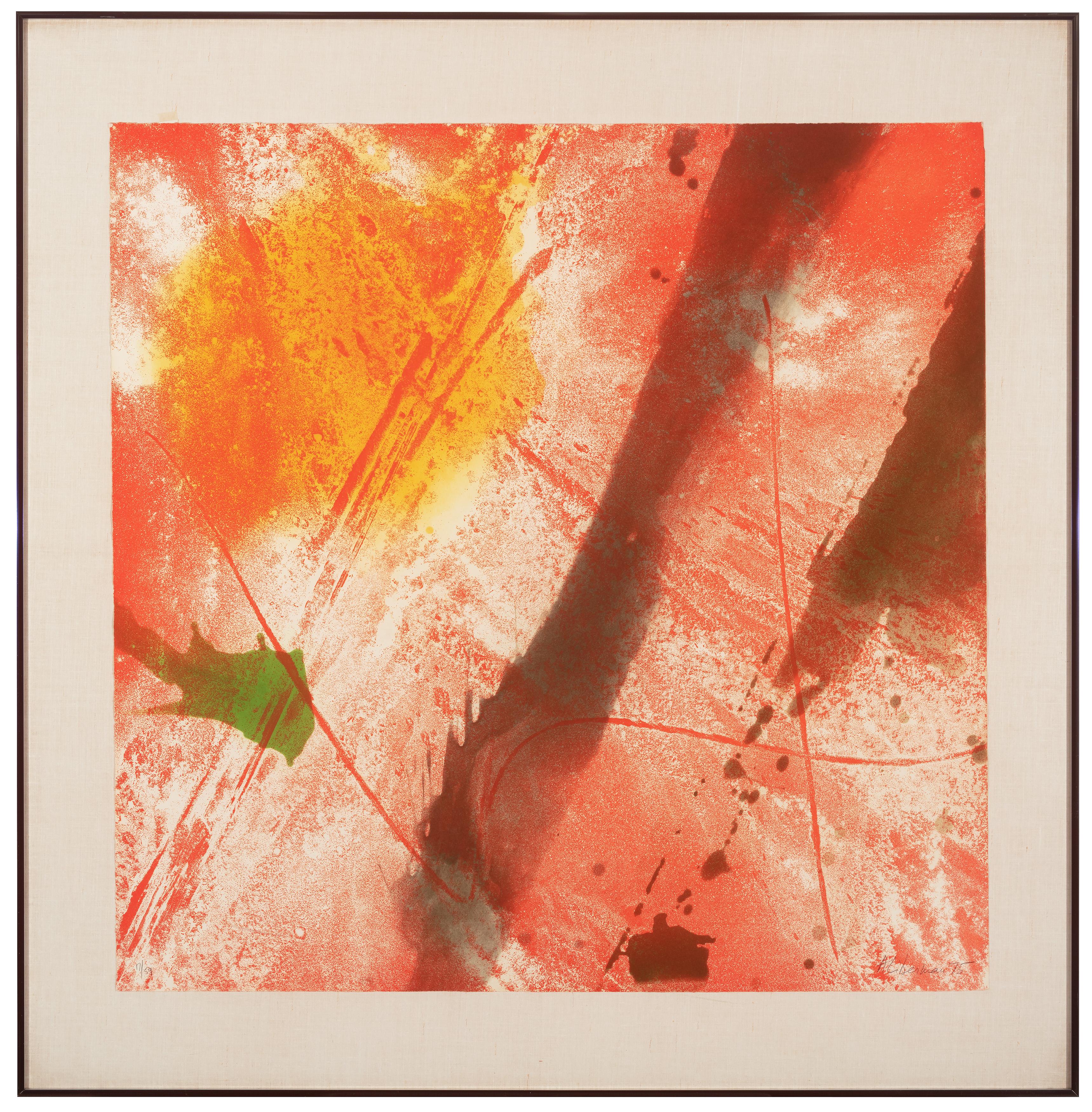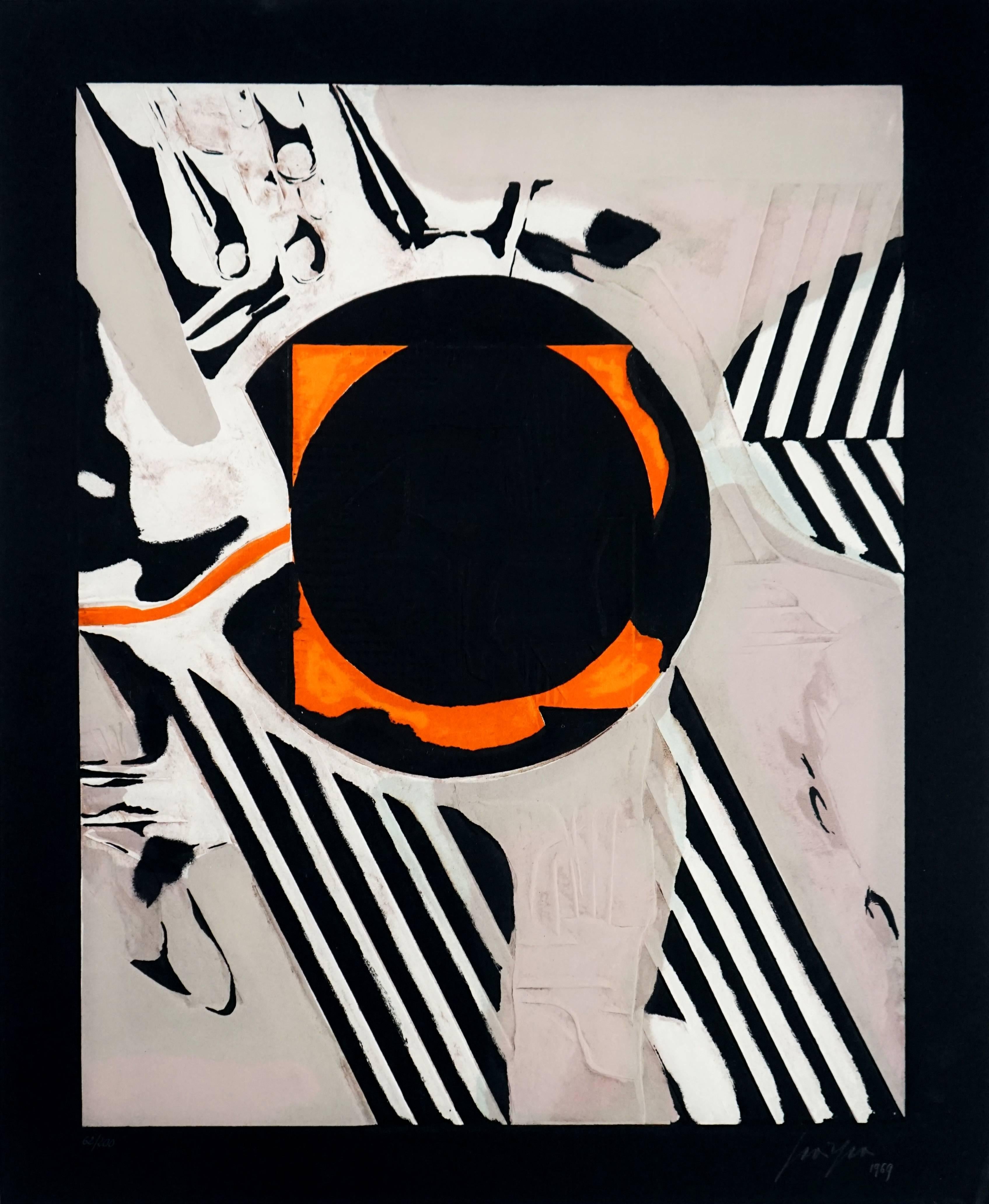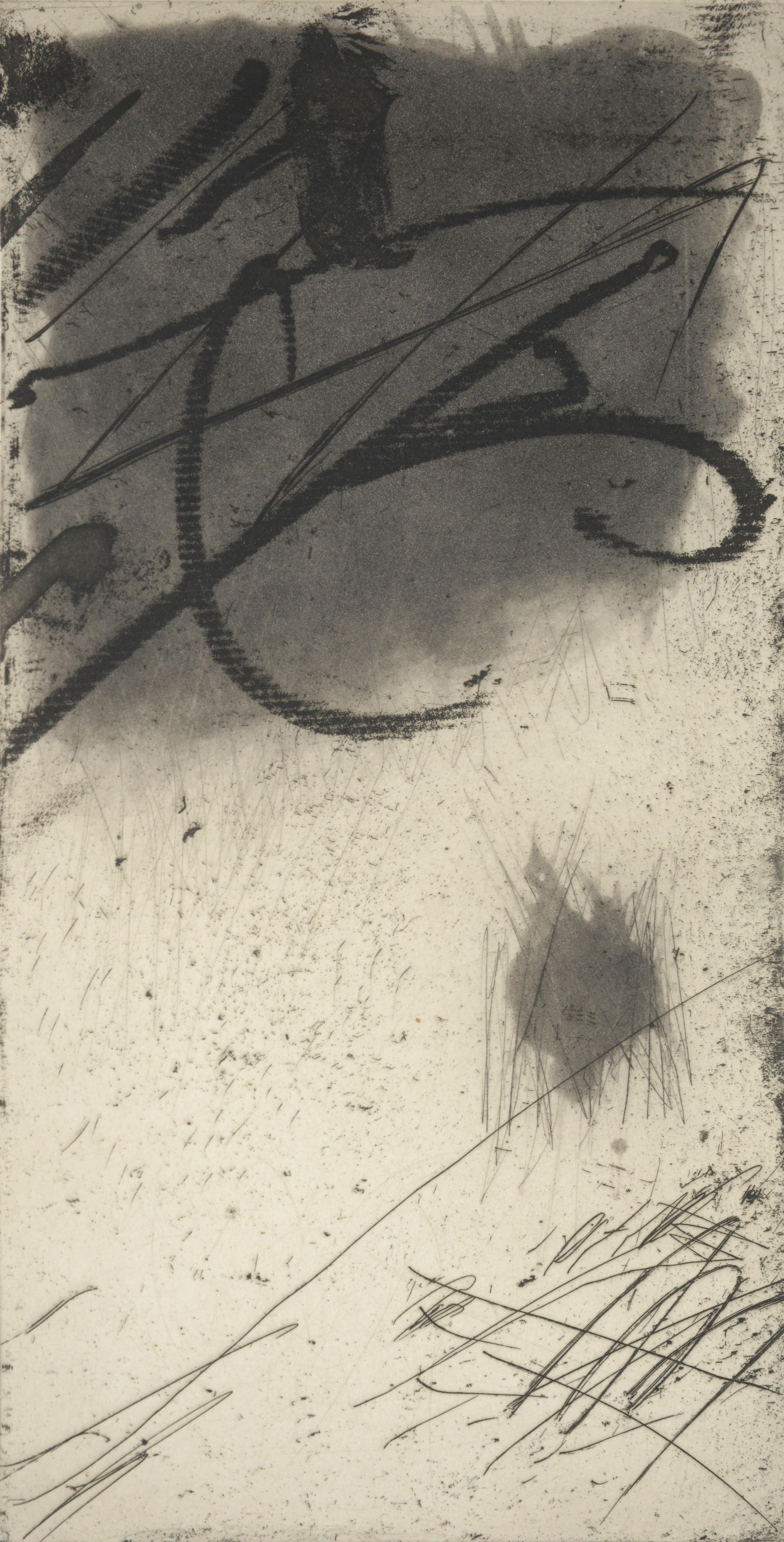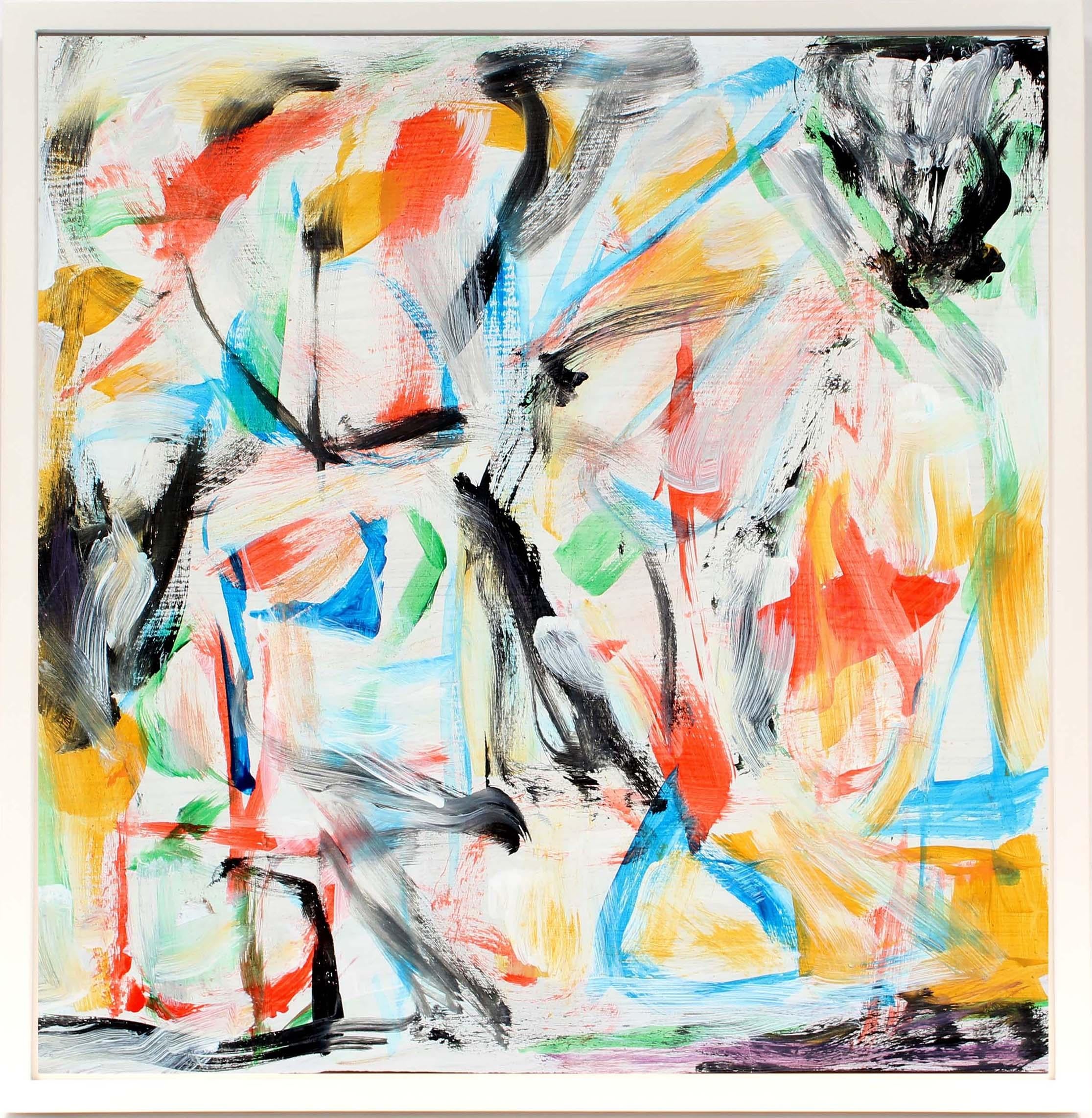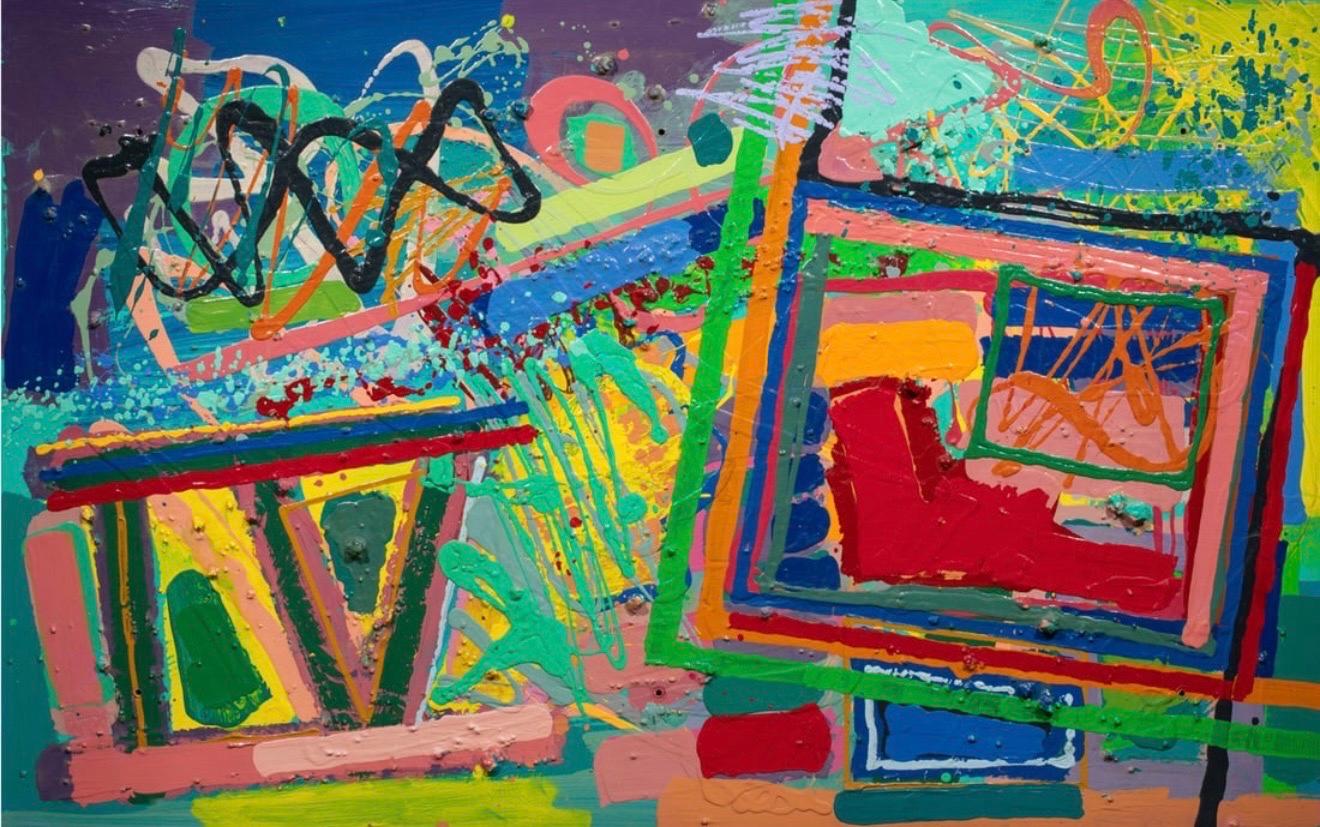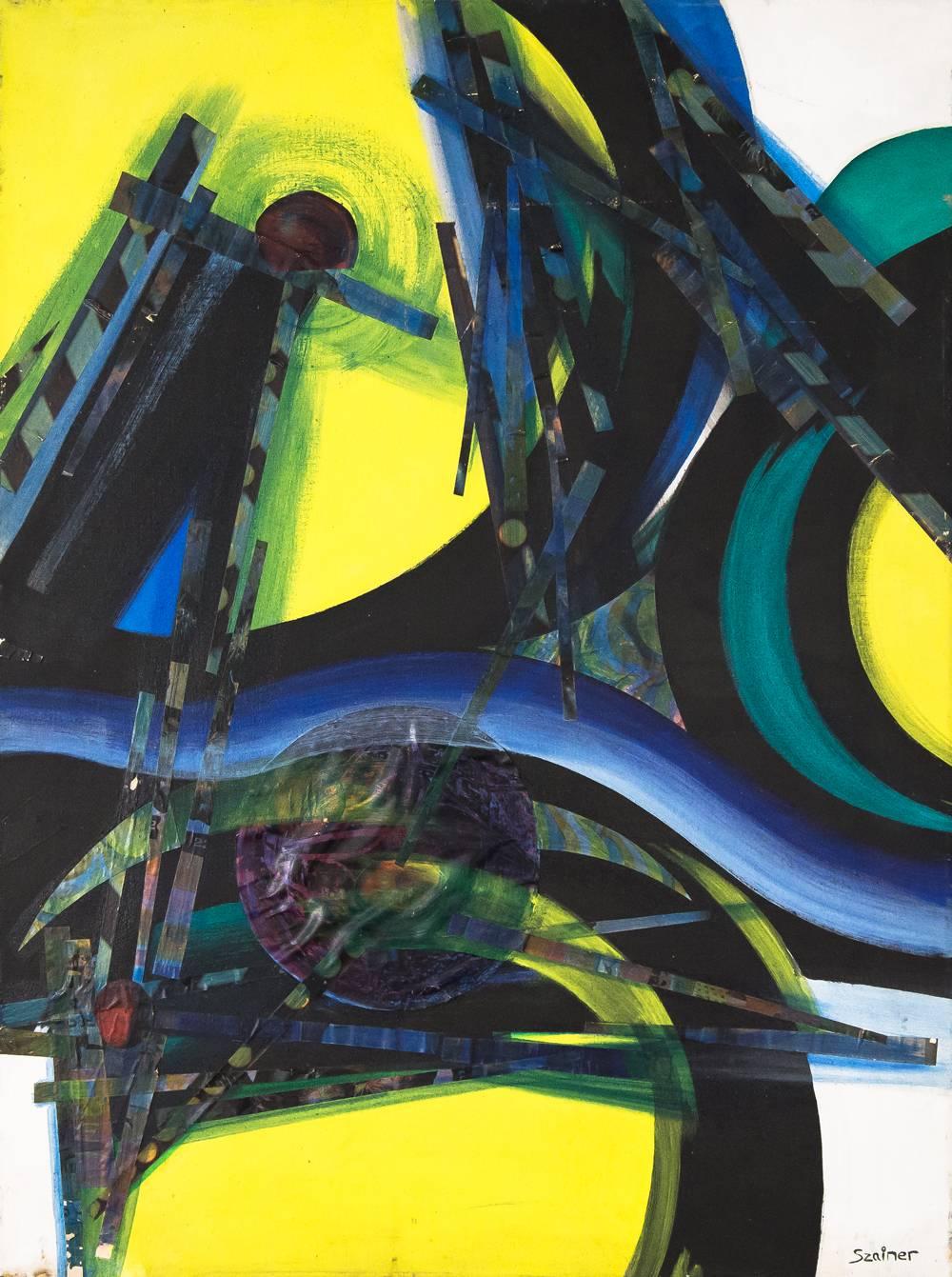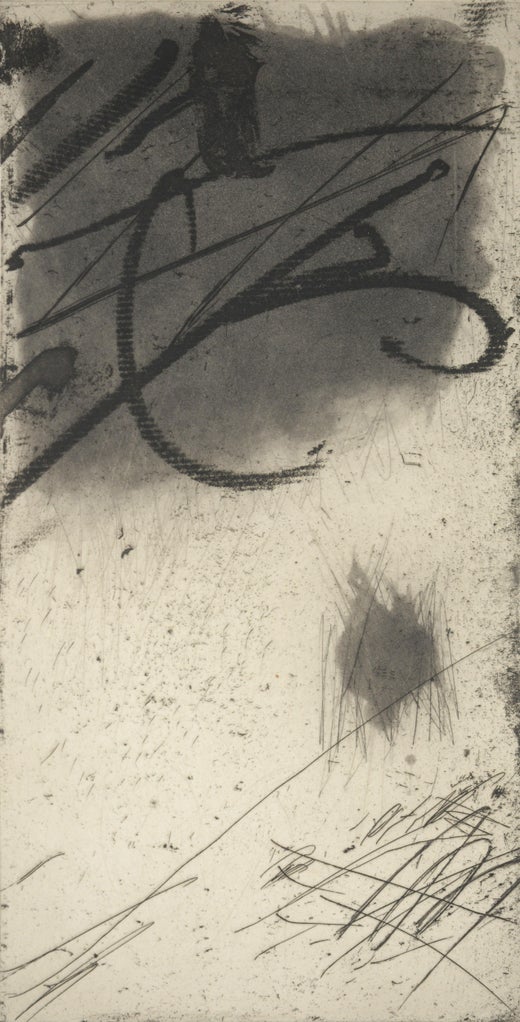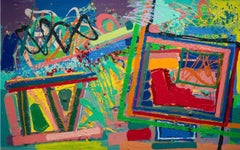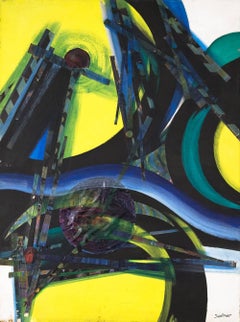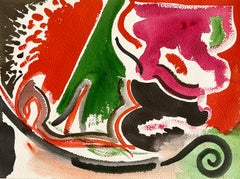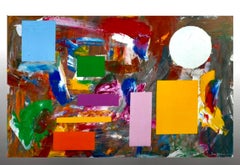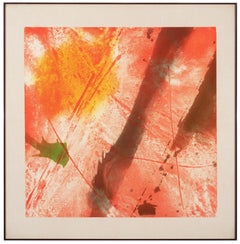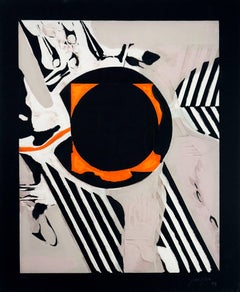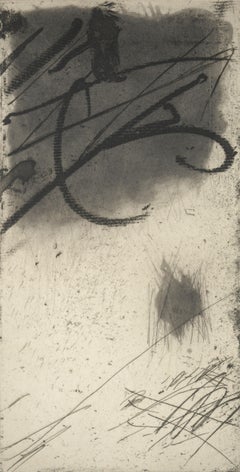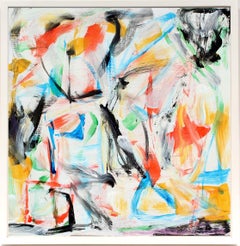Items Similar to Large Modernist Alexander Liberman Contemporary Mixed Media Painting Svet III
Want more images or videos?
Request additional images or videos from the seller
1 of 14
Alexander LibermanLarge Modernist Alexander Liberman Contemporary Mixed Media Painting Svet III1984
1984
$28,000
£21,189.95
€24,337.78
CA$39,817.35
A$43,170.21
CHF 22,750.61
MX$524,991.89
NOK 283,053.73
SEK 267,673.92
DKK 181,695.15
About the Item
Alexander Liberman (1912-1999): Svet III
Mixed media on board, 1984, signed 'Alexander Liberman' and dated at bottom=
Hand signed, titled and dated on the reverse.
92 x 90 in. (overall), This piece is not framed as designed.
Exhibited: Andre Emmerich Gallery, NY, Alexander Liberman: Recent Work, 1986.
Provenance: Andre Emmerich Gallery, NY; The Abrams Family Collection.
Harry N. Abrams and his son Robert amassed a collection of fine art and illustrated books from an industry they pioneered. Isamu Noguchi, Alex Katz, Bob Thompson, Marisol, Chryssa, Tom Wesselmann, Robert Indiana, Fernando Botero, Marisol, John Wesley, Kenneth Noland, Christo, Lee Bontecou, Dan Christensen, Arman and more were included. The collection charts a remarkable and fearless story of contemporary art: there were no aesthetic boundaries to their collecting in terms of abstraction versus figuration, gender, racial or nationalistic guidelines—instead, the supreme unifying factor above all was quality.
Alexander Semyonovitch Liberman (1912 – 1999) was a Ukrainian-American magazine editor, publisher, painter, (oil painting sand lithograph works) photographer, and sculptor. He held senior artistic positions during his 32 years at Condé Nast Publications.
Alex Lieberman was born into a Jewish family in Kyiv. When his father took a post advising the Russian Soviet government, the family moved to Moscow. Life there became difficult, and his father secured permission from Lenin and the Politburo to take his son to London in 1921. Young Alexander Lieberman was educated in Ukraine, England, and France, where he took up life as a "White émigré" in Paris.
He began his publishing career in Paris in 1933–1936 with the early pictorial magazine Vu, where he worked under Lucien Vogel as art director, then managing editor, working with photographers such as Brassaï, André Kertész, and Robert Capa.
After emigrating to New York in 1941, he began working for Condé Nast Publications, rising to the position of editorial director, which he held from 1962 to 1994. He reshaped the look and layout of every publication he touched with his avant-garde vision. He orchestrated, for example, the use of Jackson Pollock abstract expressionist paintings in Cecil Beaton’s famous fashion shoot. Only in the 1950s did Liberman take up painting and, later, metal sculpture. His highly recognizable welded and painted steel sculptures are assembled from industrial objects (segments of steel I-beams, pipes, drums, and such), often painted in uniform bright colors. In a 1986 interview concerning his formative years as a sculptor and his aesthetic, Liberman said, "I think many works of art are screams, and I identify with screams."
Before finding success in painting and sculpture, Liberman was a photographer. Beginning in 1948, he spent his summers visiting and photographing a generation of modern European artists working in their studios including Georges Braque, Henri Matisse, Maurice Utrillo, Marc Chagall, Marcel Duchamp, Constantin Brancusi, and Pablo Picasso. Liberman spent twelve years tracking down some of his favorite artists and photographing them in their studios. Among the 24 creators featured in the exhibit were Alberto Giacometti, Fernand Léger, Jean Arp, Max Ernst and Jean Dubuffet. And three women: Natalia Goncharova, Marie Laurencin and Germaine Richier.
In 1959 the Museum of Modern Art in New York City exhibited Liberman's photographs of artists and their studios. A year later the images were collected in Liberman's first book, The Artist in his Studio published by Viking Press (Kazanjian and Tomkins, 1993)
Awards
Gold Medal for Design, Exposition Internationale, Paris, 1937
Doctor of Fine Arts: Rhode Island School of Design, Providence, 1980
Publications
La Femme Française dans l'Art, 1936 (in French)
The Art and Technique of Color Photography: A Treasury of Color Photographs by the Staff Photographers of Vogue, House & Garden, Glamour, introduction by Aline B. Louchheim, Simon & Schuster (New York), 1951
The Artist in His Studio, foreword by James Thrall Soby, Viking Press (New York), 1960, revised edition, Random House (New York), 1988
(photographer) Greece, Gods, and Art, introduction by Robert Graves, commentaries by Iris C. Love, Viking Press (New York), 1968
Painting and Sculpture, 1950–1970, Garamond Pridemark Press (Baltimore, Maryland), 1970. By James Pilgrim and Alexander Liberman. Exhibition catalogue for the Corcoran Gallery of Art
Introduction to Vogue Book of Fashion Photography 1919–1979, by Polly Devlin (New York), 1979
Marlene: An Intimate Photographic Memoir, Random House (New York), 1992
(photographer) Campidoglio: Michelangelo's Roman Capitol, essay by Joseph Brodsky, Random House (New York), 1994
(photographer) Then: Photographs, 1925–1995, preface by Calvin Tomkins, selected and designed by Charles Churchward, Random House (New York), 1995
Liberman's work is held in the following collections:
Metropolitan Museum of Art
Storm King Art Center
Hirshhorn Museum and Sculpture Garden
Pyramid Hill Sculpture Park and Museum
Tate Gallery
Guggenheim Museum
Akron Art Museum
Frederik Meijer Gardens & Sculpture Park
- Creator:Alexander Liberman (1912 - 1999, Ukrainian)
- Creation Year:1984
- Dimensions:Height: 92 in (233.68 cm)Width: 90 in (228.6 cm)Depth: 1 in (2.54 cm)
- Medium:
- Movement & Style:
- Period:
- Condition:
- Gallery Location:Surfside, FL
- Reference Number:1stDibs: LU38216211842
Alexander Liberman
Alexander Liberman was a Russian-American artist known for his signature red steel sculptures and geometric paintings, in addition to his 30-year tenure at the helm of Condé Nast as its editorial director.
About the Seller
4.9
Platinum Seller
Premium sellers with a 4.7+ rating and 24-hour response times
Established in 1995
1stDibs seller since 2014
1,812 sales on 1stDibs
Typical response time: 1 hour
- ShippingRetrieving quote...Shipping from: Surfside, FL
- Return Policy
Authenticity Guarantee
In the unlikely event there’s an issue with an item’s authenticity, contact us within 1 year for a full refund. DetailsMoney-Back Guarantee
If your item is not as described, is damaged in transit, or does not arrive, contact us within 7 days for a full refund. Details24-Hour Cancellation
You have a 24-hour grace period in which to reconsider your purchase, with no questions asked.Vetted Professional Sellers
Our world-class sellers must adhere to strict standards for service and quality, maintaining the integrity of our listings.Price-Match Guarantee
If you find that a seller listed the same item for a lower price elsewhere, we’ll match it.Trusted Global Delivery
Our best-in-class carrier network provides specialized shipping options worldwide, including custom delivery.More From This Seller
View AllLarge Mod Abstract Expressionist Modernist Edward Avedisian Color Field Painting
By Edward Avedisian
Located in Surfside, FL
Edward Avedisian (American, 1936-2007)
Abstract Large Painting
Acrylic on panel heavily textured with a 3D effect.
Dimensions: 48"h x 75"w
Circa late 1970s, early 1980s
Provenance: ...
Category
1970s Abstract Expressionist Abstract Paintings
Materials
Acrylic, Wood Panel
Abstract mixed Media Collage Vibrant Painting
By Armand Szainer
Located in Surfside, FL
Genre: Contemporary
Subject: Abstract
Medium: Mixed Media
Surface: Canvas
Country: United States
Dimensions: 32.25" x 24.25"
commissions for movie advertisements, stage sets...
Category
20th Century Abstract Expressionist Abstract Paintings
Materials
Mixed Media
Mod Abstract Expressionist Modernist Edward Avedisian Color Field Art Gouache
By Edward Avedisian
Located in Surfside, FL
Edward Avedisian Gouache Watercolor Abstract Painting on Arches paper. (notebook cover not included)
Unsigned, (bears name verso in pencil.)
Dimensions: 10" X 14"
Late 1970s, early 1...
Category
1970s Abstract Expressionist Abstract Paintings
Materials
Watercolor, Gouache
Large New York School Abstract Expressionist Colorful Mixed Media Painting
By Taro Yamamoto
Located in Surfside, FL
Taro Yamamoto, (American, 1919-1994)
"La Gatta Miso"
Oil or Acrylic/Canvas
32" x 50"
Hand signed lower right, dated 1990,
Titled on the stretcher verso, unframed.
Taro Yamamoto (...
Category
1950s Abstract Expressionist Abstract Paintings
Materials
Canvas, Oil, Acrylic
Mod Abstract Expressionist Modernist Edward Avedisian Color Field Art Gouache
By Edward Avedisian
Located in Surfside, FL
Edward Avedisian Gouache Watercolor Abstract Painting on Arches paper. (notebook cover not included)
Unsigned, (bears name verso in pencil.)
Dimensions: 10" X 14"
Late 1970s, early ...
Category
1970s Abstract Expressionist Abstract Paintings
Materials
Watercolor, Gouache
1960's Large Colorful Abstract Expressionist Swiss Oil Painting Robert Lauro
Located in Surfside, FL
Oil Painting on canvas
Hand signed to lower right Lauro.
Provenance: Eleonore Austerer Gallery, San Francisco, CA
Work Size: 39.5 x 39.5 in. framed 44 X 44 inches.
Roberto Lauro is a British-Swiss Post War & Contemporary artist who was born in 1932.
Roberto Lauro was born in 1932 in Gorey Harbor on the island of Jersey (Great Britain) the son of a Swiss mother, Rosa Ramseier, from Oberdiessbach / Emmental, Switzerland, and and Italian father Innocenzo Roberto Lauro, born in Mondovi, Italy. In 1941 he moved to Switzerland with his mother. 1949-1953 he lived in Gunten (Switzerland) where he did an Apprenticeship as a lithograph and offset printer and graphic designer in Thun. There he was introduced to the color theory of Johannes Itten by Hermann Oberli at the Bern School of Applied Arts. From 1953 to 1955 he worked as a fine art printer in Norway where he was influenced by the color theory of Edvard Munch. These works bears the influence of Russian artist Andre Lanskoy, Tachisme and the Cobra artists Karel Appel, Constant, Corneille, Christian Dotremont, Asger Jorn, and Joseph Noiret.
In 1955-1956 he worked as an offset printer in Amsterdam (Netherlands). Visit to the Instituut voor Kunstnijverheidsonderwijs. In 1957 he returned to Gunten, Switzerland. Where he started working in printmaking and and oil painting. He resumed his studies at the Bern School of Applied Arts. He was greatly impacted and influenced by abstract art on the occasion of a large Paul KIee exhibition. In 1958 he moved to Zurich where he worked part-time work as an offset copyist; fulfilling graphic orders for advertising agencies. In 1962 he took his final examination as graphic designer at the Zurich School of Applied Arts. In 1980 he begins his development of three-dimensional picture objects, Sculpture, detachment from the canvas, using metal as a support and play space for light and color. By 1981 he has turned full time to fine art. He spends the next years growing and developing his considerable talent. Inspired by classical music, the rhythm, mood and lightness of which form the basis for the large swings and loops of his colorfully lacquered metal and blown glass sculptures. These are "pensieri", thought sketches that capture the emotions in countless versions. There is something dance-like about his rotating sculptures. Everything becomes music and the rhythm of colors. In 1988, after exhibitions in Europe, he has his first exhibitions in Atlanta and San Francisco (USA), In 1989 he does his first glass and metal sculptures at the Roberto Niederer glassworks, Hergiswil (Switzerland). In 1992 has a retrospective exhibition in the Tan Gallery, Zurich, and the Eleonore Austerer Gallery, San Francisco. They Publish a catalogue raisonne, Eine Retrospektive, covering a 45 year career. In 1993 he creates A Retrospective, a unique sculpture in a table top form that contains his catalogue raisonne and an original lithograph.
1993–1995 he begins work on a number of large scale public outdoor commissions, including Light Columns for a Bank building, and a commission of a sculpture-fountain in Oetwil am See. In 2001 he creates a wall sculpture entitled "Color Poems of the Yearly Cycle. A linen bound book enclosed in a unique plexi display with a one - of a - kind metal and glass sculpture,containing 12 linocuts each printed in colors and signed.
Roberto Lauro's sculptural work work is spontaneous and loaded with energy. The furrows, rifts, cracks and scars in the metal allow light to enter; it is then reflected back by the glass. His work is a clear statement of our times, uniting the intellect and the heart in search of the spiritual. Like the interplay of light and shadow, his sculpture combines fragile, transparent glass with solid, heavy iron. These colorful and luminous sculptures convey a powerful presence and emit vibrant positive energy. With their jagged exteriors and translucent cores, the spectacular sculptures created by the synergy of metal and glass are powerful - yet fragile. Lauro has created and mastered his own idiom and proven that through the artist sheer will and vision, seemingly incompatible materials such as iron and glass can indeed be combined. In 2004 he has an anniversary exhibition Light and Color, Love of Life on the island of birth, Jersey. Ceramic works (raku with glass inclusions). Roberto Lauro's works have been shown in numerous exhibitions in Europe and the USA around the world, and he has also realized projects such as "KUNST AM BAU" in public spaces and for industry. He lives and works in Switzerland.
Select Exhibitions
Eleonore Austerer Gallery, Palm Desert
ART IN THE FRAME FOUNDATION: The Harbour Gallery, Isle of Jersey
Galerie fur Gegenwartskunst,, Bonstetten, Switzerland
Galerie Annamarie Anderson, Zurich, Switzerland
“Color and Light,” Austerer-Crider Gallery, Palm Springs, CA, USA
“Color and Light: the art of Roberto Lauro,” Eleonore Austerer Gallery, San Francisco, CA, USA
“Flower Power,” with Ed Baynard, Roberto Azank, Siegward Sprotte, and Daniel Phil...
Category
1960s Abstract Expressionist Abstract Paintings
Materials
Canvas, Oil
You May Also Like
"Abstract"
By Alexander Liberman
Located in New Orleans, LA
Alexander Liberman (Ukrainian/American 1912-19990 Colored lithograph, signed in the lower right and dated '75 in pencil, numbered in the lower left, and presented in a chrome frame.
...
Category
1970s Abstract Paintings
Materials
Lithograph
Untitled 148
By Gino Scarpa
Located in Austin, TX
Artist: Gino Scarpa, Italian/Norwegian (1924 - )
Title: Untitled 148
Year: circa 1970
Medium: Aquatint Etching and Carborundum Intaglio print
Signed and numbered in pencil, Numbe...
Category
1970s Abstract Expressionist Abstract Prints
Materials
Etching, Aquatint, Intaglio
$385 Sale Price
65% Off
Alexander Liberman CARTELLA Print
By Alexander Liberman
Located in Lake Worth Beach, FL
Artist/Designer; Manufacturer: Alexander Liberman (Ukrainian/American, 1912-1999)
Marking(s); notes: signed; ed. 27/34; 1976
Materials: paper
Dimensions (H, W, D): 23.5"h, 15"w; 26.2...
Category
1970s Modern Abstract Prints
Materials
Offset
Abstract Expressionist Painting American 1960's Mid Century New York Colorful
Located in Buffalo, NY
Mid Century Modern, American Abstract Expressionist Painting on Masonite.
This wonderful work in exciting colors is housed in a contemporary white wood frame presentation..
The art...
Category
1960s Abstract Expressionist Abstract Paintings
Materials
Masonite, Acrylic
$340 Sale Price
20% Off
Mid century Modern 1960s Abstract Expressionist painting, renowned artist Signed
Located in New York, NY
Jack Wolfe
Untitled, 1965
Acrylic and collage on board
Hand signed on the front
Frame included: held in original vintage frame with original gallery label
Unique
Provenance: Parker Street 470 Gallery, Boston, Mass (with label verso)
Excellent abstract expressionist mixed media work.
Measurements:
Image:
17" x 24"
Framed:
24" x 28" x 1"
From Wiki:
Jack Wolfe (14 January 1924 – 18 November 2007) was a 20th-century American painter most known for his abstract art, portraiture, and political paintings. Jack Wolfe was born in Omaha, Nebraska on January 14, 1924, to Blanche and Everett L. Wolfe. Soon after his birth, his family moved to Brockton, MA. At 18, Wolfe had an interest in commercial illustration, which he pursued at the Rhode Island School of Design (RISD). However, upon matriculating at RISD in 1942, he developed an interest in fine art and painting inspired by an exhibition of modern French art. He described this change of direction, explaining that, "One day, for the first time, I saw an exhibition of modern French art. It was like being struck by lightning." He became particularly interested in the work of a number of European modernists, including Rouault, Cézanne, Braque, Modigliani, and Picasso.[1] Following his time at RISD, he pursued a Master’s in Fine Arts degree at the Museum of Fine Arts School in Boston, MA. At the Museum School, Wolfe studied under the renowned Expressionist Karl Zerbe, a German-born artist who was the Museum School's most influential and vital teacher until 1953.[2] After graduating from the Museum School, Wolfe was represented by the Margaret Brown Gallery in Boston, which also represented many other cutting edge Moderns that defied the more conservative tastes of New England collectors at the time, including György Kepes, Congur Metcalf, and Alexander Calder.[3]
Career and Museum Representation
Jack Wolfe's painting "Robin's Rock" 1962, 72" x 72"
Jack Wolfe's artwork received early recognition from a number of organizations and was consistently featured in influential exhibitions, including the 1955 Carnegie International at the Carnegie Institute in Pittsburgh, PA, the American Federation of Art's traveling exhibition New Talent in the USA in 1956-57, the Whitney Museum’s Young America exhibition in 1957,[4] the Boston Institute of Contemporary Art's Selection exhibition in 1957,[5] and both the Whitney Museum’s 1958 Annual exhibition and its Forty Artists Under Forty show in 1962-63.[6] In 1959, his widely acclaimed Portrait of Abraham Lincoln toured Europe in a show circulated by the Institute of Contemporary Art, Boston. In addition, his painting Crucifixion was chosen by the United States Information Agency to be exhibited across Europe, including being shown at the Salzburg Biennial in Austria in 1958.[7] Crucifixion was also exhibited at the Whitney Museum and subsequently displayed in the National Cathedral in Washington, DC, in 1958.[8] In 1966-67, his work was selected for Art for Embassies by the U.S. State Department.[9] He received the first annual Margaret Brown Memorial Award for high achievement by a New England Artist from the Institute of Contemporary Art, Boston, in 1958.[10]
With his future as one of the great artists of his time laid out neatly before him, Wolfe moved to New York in the early 1950s, which was then the postwar epicenter of the art world and in the midst of experiencing the first real revolution in American Art, now known as Abstract Expressionism.[11] However, almost immediately upon his arrival, he became disenfranchised with the overtly commercial nature of the art scene there, spurning fame and security in an unwillingness to bend his creative vision to the expectations of others.[12] After four short months, he left New York, returned to Massachusetts where he bought property in Stoughton, cleared the land, and built both his home and studio with his own two hands. He would go on to live and paint there, extensively exhibiting and garnering constant critical acclaim.[13]
Wolfe became one of the earliest artists championed by the deCordova Museum in Lincoln, MA and the Institute of Contemporary Art in Boston. He was awarded a traveling scholarship in 1958,[6] which allowed him to set up studio in San Miguel de Allende, Mexico and then in San Francisco, California.[14] Upon his return in 1959, the deCordova museum hosted Wolfe’s third solo exhibition, featuring work made during his time in California...
Category
1960s Abstract Expressionist Abstract Paintings
Materials
Mixed Media, Acrylic, Gouache, Permanent Marker
Abstract Expressionist Painting American 1960's Mid Century New York Colorful
Located in Buffalo, NY
Mid Century Modern, American Abstract Expressionist Painting on Masonite.
This wonderful work in exciting colors is housed in a contemporary white wood frame presentation..
The art...
Category
1960s Abstract Expressionist Abstract Paintings
Materials
Masonite, Acrylic
$340 Sale Price
20% Off
